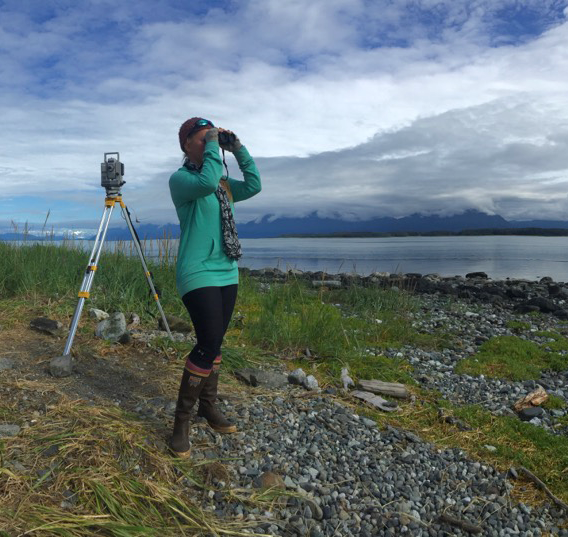Michelle Fournet, Postdoctoral Fellow My research interests are in animal communication, the impact of anthropogenic noise on animal behavior, and how interspecies interactions manifest acoustically. I work primarily in the marine realm, but I am generally interested in using acoustics to investigate questions of applied ecological significance and to disseminate science to the greater public.
For my graduate work I investigated humpback whale (Megaptera novaeangliae ) acoustic ecology and the impact of vessel noise on humpback whale calling behavior in Southeast Alaska. This included classifying the humpback whale acoustic repertoire on North Pacific foraging grounds, quantifying and describing the role of non-song vocalizations within the humpback whale acoustic repertoire, quantifying the contribution of biotic and abiotic noise to the marine soundscape, measuring humpback call source levels (loudness), and assessing shifts in vocal behavior as a response to vessel noise.
As a postdoctoral researcher at the Cornell Lab’s K. Lisa Yang Center for Conservation Bioacoustics (CCB), I am using acoustics to understand community dynamics in Florida Bay, Everglades National Park, with an emphasis on sonic fishes. We hope to expand the breadth and depth of our knowledge of ecosystem dynamics in Florida Bay by applying well established passive acoustic monitoring techniques to acoustically active species like sub-tropical fishes. In this way we can non-invasively increase the spatial and temporal resolution of our observations, not unlike that which is done for marine mammals.
Former projects include humpback whale and killer whale photo-identification and citizen-science program development in Juneau, Alaska, the coordination and development of a marine mammal observation effort in Oregon’s near-shore ocean, and the analysis long-term acoustic data sets from Alaska’s Beaufort Sea, where I investigated seasonal presence of bowhead whales (Balaena mysticetus ) and arctic seals. Teaching and mentoring credits include undergraduate internship development and university teaching at Oregon State University, internship development and mentoring from the Five Finger Lighthouse in Frederick Sound, Alaska, and field mentorship programs at Glacier Bay National Park.
Year Hired : 2018
Contact information michelle.fournet@cornell.edu
Degree(s) :
Other: https://MichelleFournet.wordpress.com/
Recent Publications
2394371
Fournet
items
1
15
default
desc
year
Fournet
4118
https://www.birds.cornell.edu/ccb/wp-content/plugins/zotpress/
%7B%22status%22%3A%22success%22%2C%22updateneeded%22%3Afalse%2C%22instance%22%3A%22zotpress-10d9ef81174e6a2fcf32227f0dfc46a0%22%2C%22meta%22%3A%7B%22request_last%22%3A0%2C%22request_next%22%3A0%2C%22used_cache%22%3Atrue%7D%2C%22data%22%3A%5B%7B%22key%22%3A%22P7Z5QTIS%22%2C%22library%22%3A%7B%22id%22%3A2394371%7D%2C%22meta%22%3A%7B%22creatorSummary%22%3A%22Fournet%20et%20al.%22%2C%22parsedDate%22%3A%222022-09-05%22%2C%22numChildren%22%3A1%7D%2C%22bib%22%3A%22%3Cdiv%20class%3D%5C%22csl-bib-body%5C%22%20style%3D%5C%22line-height%3A%201.35%3B%20%5C%22%3E%5Cn%20%20%3Cdiv%20class%3D%5C%22csl-entry%5C%22%3E%3Cstrong%3EFournet%3C%5C%2Fstrong%3E%2C%20M.EH.%20%3Ci%3Eet%20al.%3C%5C%2Fi%3E%20%282022%29%20%26%23x2018%3BAltered%20acoustic%20community%20structure%20indicates%20delayed%20recovery%20following%20ecosystem%20perturbations%26%23x2019%3B%2C%20%3Ci%3EEstuarine%2C%20Coastal%20and%20Shelf%20Science%3C%5C%2Fi%3E%2C%20274%2C%20p.%20107948.%20Available%20at%3A%20%3Ca%20href%3D%27https%3A%5C%2F%5C%2Fdoi.org%5C%2F10.1016%5C%2Fj.ecss.2022.107948%27%3Ehttps%3A%5C%2F%5C%2Fdoi.org%5C%2F10.1016%5C%2Fj.ecss.2022.107948%3C%5C%2Fa%3E.%3C%5C%2Fdiv%3E%5Cn%3C%5C%2Fdiv%3E%22%2C%22data%22%3A%7B%22itemType%22%3A%22journalArticle%22%2C%22title%22%3A%22Altered%20acoustic%20community%20structure%20indicates%20delayed%20recovery%20following%20ecosystem%20perturbations%22%2C%22creators%22%3A%5B%7B%22creatorType%22%3A%22author%22%2C%22firstName%22%3A%22Michelle%20EH.%22%2C%22lastName%22%3A%22Fournet%22%7D%2C%7B%22creatorType%22%3A%22author%22%2C%22firstName%22%3A%22Erik%22%2C%22lastName%22%3A%22Stabenau%22%7D%2C%7B%22creatorType%22%3A%22author%22%2C%22firstName%22%3A%22Shyam%22%2C%22lastName%22%3A%22Madhusudhana%22%7D%2C%7B%22creatorType%22%3A%22author%22%2C%22firstName%22%3A%22Aaron%20N.%22%2C%22lastName%22%3A%22Rice%22%7D%5D%2C%22abstractNote%22%3A%22In%20the%20Anthropocene%2C%20there%20is%20an%20intensification%20of%20ecological%20disturbances%20that%20can%20be%20directly%20or%20indirectly%20attributed%20to%20human%20activities.%20Seagrass%20meadows%20are%20among%20the%20most%20imperiled%20ecosystems%20worldwide%20and%20are%20particularly%20sensitive%20to%20anthropogenic%20disturbance%20events.%20In%20Everglades%20National%20Park%2C%20Florida%2C%20USA%2C%20ecological%20disturbances%20including%20widespread%20seagrass%20die%20offs%2C%20can%20in%20part%20be%20attributed%20to%20anthropogenic%20alteration%20of%20historic%20freshwater%20flow.%20In%20this%20study%2C%20we%20assess%20the%20impacts%20of%20seagrass%20die%20offs%20on%20the%20composition%20and%20behavior%20of%20aquatic%20organisms%20in%20acoustic%20communities%20at%20two%20ecologically%20similar%20sites%20in%20Florida%20Bay%3A%20Buoy%20Key%2C%20which%20experienced%20massive%20seagrass%20die%20off%20in%202015%2C%20and%20Little%20Rabbit%20Key%2C%20which%20did%20not.%20We%20focused%20on%20three%20sonic%20indicator%20species%20for%20North%20American%20estuaries%20and%20coastal%20ecosystems%2C%20and%20specifically%20Florida%20Bay%3A%20spotted%20seatrout%20%28Cynoscion%20nebulosus%2C%20family%20Sciaenidae%29%2C%20gulf%20toadfish%20%28Opsanus%20beta%2C%20family%20Batrachoididae%29%2C%20and%20snapping%20shrimp%20%28Alpheus%20spp.%20and%20Synalpheus%20spp.%2C%20family%20Alpheidae%29.%20The%20sounds%20produced%20by%20these%20species%20are%20collectively%20indicative%20of%20a%20broader%20range%20of%20ecosystem%20function%20and%20services%20%5Cu2013%20including%20trophic%20transfer%20and%20recreational%20fishing%20%5Cu2013%20and%20are%20more%20indicative%20of%20ecosystem%20functioning%20at%20varying%20temporal%20scales%20than%20any%20one%20species%20alone.%20Using%20a%20combination%20of%20automated%20detection%20and%20visual%20spectrographic%20analysis%20on%20passive%20acoustic%20data%2C%20we%20found%20that%20the%20occurrence%20of%20seatrout%20and%20toadfish%20calls%20and%5C%2For%20chorusing%20were%20significantly%20lower%20at%20the%20disturbed%20site%20than%20the%20undisturbed%20site%2C%20with%20no%20seatrout%20or%20toadfish%20breeding%20choruses%20detected%20at%20the%20disturbed%20location.%20At%20both%20sites%2C%20toadfish%20call%20properties%20exhibited%20a%20direct%20relationship%20with%20water%20temperature.%20Snapping%20shrimp%20snap%20rates%20were%20significantly%20lower%20at%20the%20disturbed%20site%2C%20and%20snap%20rates%20were%20positively%20related%20to%20temperature%20at%20the%20undisturbed%20location.%20Further%2C%20examination%20of%20a%20short-duration%2C%20pre-disturbance%20acoustic%20dataset%2C%20showed%20minimal%20differences%20in%20the%20acoustic%20occurrence%20of%20the%20three%20species%20at%20the%20disturbed%20site%20between%202015%20immediately%20after%20the%20die%20off%20and%202018.%20These%20results%20support%20the%20hypothesis%20that%20by%202018%20the%20disturbed%20site%20had%20not%20fully%20recovered%20from%20the%20most%20recent%20seagrass%20die%20off%20and%20that%20restoration%20efforts%20may%20still%20needed.%20Acoustic%20community%20composition%20and%20behavior%20may%20be%20used%20as%20a%20reliable%20indicator%20of%20ecosystem%20health%20and%20restoration%20success%20or%20efficacy.%20This%20work%20lays%20the%20conceptual%20groundwork%20for%20using%20acoustic%20communities%20as%20indicators%20in%20human%20altered%20systems%20to%20inform%20managers%20that%20habitats%20either%20may%20be%20approaching%20disturbance%20or%20may%20require%20continued%20restoration%20efforts%20to%20meet%20achieve%20recovery%20goals.%22%2C%22date%22%3A%222022-09-05%22%2C%22language%22%3A%22en%22%2C%22DOI%22%3A%2210.1016%5C%2Fj.ecss.2022.107948%22%2C%22ISSN%22%3A%220272-7714%22%2C%22url%22%3A%22https%3A%5C%2F%5C%2Fwww.sciencedirect.com%5C%2Fscience%5C%2Farticle%5C%2Fpii%5C%2FS0272771422002062%22%2C%22collections%22%3A%5B%22IMWW9QTW%22%5D%2C%22dateModified%22%3A%222022-06-24T17%3A31%3A03Z%22%7D%7D%2C%7B%22key%22%3A%22R5JW9Z2Q%22%2C%22library%22%3A%7B%22id%22%3A2394371%7D%2C%22meta%22%3A%7B%22creatorSummary%22%3A%22Fournet%20et%20al.%22%2C%22parsedDate%22%3A%222021-02-24%22%2C%22numChildren%22%3A0%7D%2C%22bib%22%3A%22%3Cdiv%20class%3D%5C%22csl-bib-body%5C%22%20style%3D%5C%22line-height%3A%201.35%3B%20%5C%22%3E%5Cn%20%20%3Cdiv%20class%3D%5C%22csl-entry%5C%22%3E%3Cstrong%3EFournet%3C%5C%2Fstrong%3E%2C%20M.E.H.%20%3Ci%3Eet%20al.%3C%5C%2Fi%3E%20%282021%29%20%26%23x2018%3BLimited%20vocal%20compensation%20for%20elevated%20ambient%20noise%20in%20bearded%20seals%3A%20implications%20for%20an%20industrializing%20Arctic%20Ocean%26%23x2019%3B%2C%20%3Ci%3EProceedings%20of%20the%20Royal%20Society%20B%3C%5C%2Fi%3E%2C%20288%281945%29.%20Available%20at%3A%20%3Ca%20href%3D%27https%3A%5C%2F%5C%2Fdoi.org%5C%2F10.1098%5C%2Frspb.2020.2712%27%3Ehttps%3A%5C%2F%5C%2Fdoi.org%5C%2F10.1098%5C%2Frspb.2020.2712%3C%5C%2Fa%3E.%3C%5C%2Fdiv%3E%5Cn%3C%5C%2Fdiv%3E%22%2C%22data%22%3A%7B%22itemType%22%3A%22journalArticle%22%2C%22title%22%3A%22Limited%20vocal%20compensation%20for%20elevated%20ambient%20noise%20in%20bearded%20seals%3A%20implications%20for%20an%20industrializing%20Arctic%20Ocean%22%2C%22creators%22%3A%5B%7B%22creatorType%22%3A%22author%22%2C%22firstName%22%3A%22M.%20E.%20H.%22%2C%22lastName%22%3A%22Fournet%22%7D%2C%7B%22creatorType%22%3A%22author%22%2C%22firstName%22%3A%22M.%22%2C%22lastName%22%3A%22Silvestri%22%7D%2C%7B%22creatorType%22%3A%22author%22%2C%22firstName%22%3A%22C.%20W.%22%2C%22lastName%22%3A%22Clark%22%7D%2C%7B%22creatorType%22%3A%22author%22%2C%22firstName%22%3A%22Holger%22%2C%22lastName%22%3A%22Klinck%22%7D%2C%7B%22creatorType%22%3A%22author%22%2C%22firstName%22%3A%22A.%20N.%22%2C%22lastName%22%3A%22Rice%22%7D%5D%2C%22abstractNote%22%3A%22%22%2C%22date%22%3A%2224%20February%202021%22%2C%22language%22%3A%22%22%2C%22DOI%22%3A%2210.1098%5C%2Frspb.2020.2712%22%2C%22ISSN%22%3A%22%22%2C%22url%22%3A%22%22%2C%22collections%22%3A%5B%22IMWW9QTW%22%5D%2C%22dateModified%22%3A%222021-11-30T19%3A36%3A07Z%22%7D%7D%2C%7B%22key%22%3A%22H6XPH6DP%22%2C%22library%22%3A%7B%22id%22%3A2394371%7D%2C%22meta%22%3A%7B%22creatorSummary%22%3A%22Epp%20et%20al.%22%2C%22parsedDate%22%3A%222021-08%22%2C%22numChildren%22%3A0%7D%2C%22bib%22%3A%22%3Cdiv%20class%3D%5C%22csl-bib-body%5C%22%20style%3D%5C%22line-height%3A%201.35%3B%20%5C%22%3E%5Cn%20%20%3Cdiv%20class%3D%5C%22csl-entry%5C%22%3EEpp%2C%20M.V.%20%3Ci%3Eet%20al.%3C%5C%2Fi%3E%20%282021%29%20%26%23x2018%3BAllopatric%20humpback%20whales%20of%20differing%20generations%20share%20call%20types%20between%20foraging%20and%20wintering%20grounds%26%23x2019%3B%2C%20%3Ci%3EScientific%20Reports%3C%5C%2Fi%3E%2C%2011%2816297%29.%3C%5C%2Fdiv%3E%5Cn%3C%5C%2Fdiv%3E%22%2C%22data%22%3A%7B%22itemType%22%3A%22journalArticle%22%2C%22title%22%3A%22Allopatric%20humpback%20whales%20of%20differing%20generations%20share%20call%20types%20between%20foraging%20and%20wintering%20grounds%22%2C%22creators%22%3A%5B%7B%22creatorType%22%3A%22author%22%2C%22firstName%22%3A%22M.%20V.%22%2C%22lastName%22%3A%22Epp%22%7D%2C%7B%22creatorType%22%3A%22author%22%2C%22firstName%22%3A%22M.%20E.%20H.%22%2C%22lastName%22%3A%22Fournet%22%7D%2C%7B%22creatorType%22%3A%22author%22%2C%22firstName%22%3A%22G.%20K.%22%2C%22lastName%22%3A%22Silber%22%7D%2C%7B%22creatorType%22%3A%22author%22%2C%22firstName%22%3A%22G.%20K.%22%2C%22lastName%22%3A%22Davoren%22%7D%5D%2C%22abstractNote%22%3A%22%22%2C%22date%22%3A%22August%202021%22%2C%22language%22%3A%22%22%2C%22DOI%22%3A%22%22%2C%22ISSN%22%3A%22%22%2C%22url%22%3A%22%22%2C%22collections%22%3A%5B%22IMWW9QTW%22%5D%2C%22dateModified%22%3A%222021-09-03T14%3A22%3A02Z%22%7D%7D%2C%7B%22key%22%3A%22NKZMYJTW%22%2C%22library%22%3A%7B%22id%22%3A2394371%7D%2C%22meta%22%3A%7B%22creatorSummary%22%3A%22Epp%20et%20al.%22%2C%22parsedDate%22%3A%222021-08%22%2C%22numChildren%22%3A2%7D%2C%22bib%22%3A%22%3Cdiv%20class%3D%5C%22csl-bib-body%5C%22%20style%3D%5C%22line-height%3A%201.35%3B%20%5C%22%3E%5Cn%20%20%3Cdiv%20class%3D%5C%22csl-entry%5C%22%3EEpp%2C%20M.V.%2C%20%3Cstrong%3EFournet%3C%5C%2Fstrong%3E%2C%20M.E.H.%20and%20Davoren%2C%20G.K.%20%282021%29%20%26%23x2018%3BHumpback%20whale%20call%20repertoire%20on%20a%20northeastern%20Newfoundland%20foraging%20ground%26%23x2019%3B%2C%20%3Ci%3EMarine%20Mammal%20Science%3C%5C%2Fi%3E%2C%20n%5C%2Fa%28n%5C%2Fa%29.%20Available%20at%3A%20%3Ca%20href%3D%27https%3A%5C%2F%5C%2Fdoi.org%5C%2F10.1111%5C%2Fmms.12859%27%3Ehttps%3A%5C%2F%5C%2Fdoi.org%5C%2F10.1111%5C%2Fmms.12859%3C%5C%2Fa%3E.%3C%5C%2Fdiv%3E%5Cn%3C%5C%2Fdiv%3E%22%2C%22data%22%3A%7B%22itemType%22%3A%22journalArticle%22%2C%22title%22%3A%22Humpback%20whale%20call%20repertoire%20on%20a%20northeastern%20Newfoundland%20foraging%20ground%22%2C%22creators%22%3A%5B%7B%22creatorType%22%3A%22author%22%2C%22firstName%22%3A%22Mikala%20V.%22%2C%22lastName%22%3A%22Epp%22%7D%2C%7B%22creatorType%22%3A%22author%22%2C%22firstName%22%3A%22Michelle%20E.%20H.%22%2C%22lastName%22%3A%22Fournet%22%7D%2C%7B%22creatorType%22%3A%22author%22%2C%22firstName%22%3A%22Gail%20K.%22%2C%22lastName%22%3A%22Davoren%22%7D%5D%2C%22abstractNote%22%3A%22Humpback%20whales%20%28Megaptera%20novaeangliae%29%20are%20a%20highly%20vocal%20baleen%20whale%20species%20with%20a%20diverse%20acoustic%20repertoire.%20%5Cu201cSong%5Cu201d%20has%20been%20well%20studied%2C%20while%20discrete%20%5Cu201ccalls%5Cu201d%20have%20been%20described%20in%20a%20limited%20number%20of%20regions.%20We%20aimed%20to%20quantitatively%20describe%20calls%20from%20coastal%20Newfoundland%2C%20Canada%2C%20where%20foraging%20humpback%20whales%20aggregate%20during%20the%20summer.%20Recordings%20were%20made%20in%20July%5Cu2013August%202015%20and%202016.%20Extracted%20calls%20were%20assigned%20to%20call%20types%20using%20aural%5C%2Fvisual%20%28AV%29%20characteristics%2C%20and%20then%20agreement%20between%20quantitative%20acoustic%20parameters%20and%20qualitative%20call%20assignments%20was%20assessed%20using%20a%20supervised%20random%20forest%20%28RF%29%20analysis.%20The%20RF%20classified%20calls%20well%20%2896%25%20agreement%29%20into%20three%20broad%20classes%20%28high%20frequency%20%28HF%29%2C%20low%20frequency%20%28LF%29%2C%20pulsed%20%28P%29%29%2C%20but%20agreement%20for%20call%20types%20within%20classes%20was%20lower%20%28LF%3A%2063%25%3B%20P%3A%2085%25%3B%20HF%3A%2081%25%29.%20We%20found%20support%20for%20a%20repertoire%20of%2013%20call%20types%20based%20on%20either%20high%20%28%5Cu226570%25%29%20RF%20agreement%20%289%20call%20types%29%20or%20high%20%28%5Cu226570%25%29%20AV%20agreement%20between%20two%20observers%20%284%20call%20types%29.%20Five%20call%20types%20%28swops%2C%20droplets%2C%20teepees%2C%20growls%20and%20whups%29%20were%20qualitatively%20similar%20to%20call%20types%20from%20other%20regions.%20We%20propose%20that%20the%20variable%20classification%20agreement%20is%20reflective%20of%20the%20graded%20nature%20of%20humpback%20whale%20calls%20and%20present%20a%20gradation%20model%20to%20demonstrate%20the%20suggested%20continuum.%22%2C%22date%22%3A%22August%202021%22%2C%22language%22%3A%22en%22%2C%22DOI%22%3A%2210.1111%5C%2Fmms.12859%22%2C%22ISSN%22%3A%221748-7692%22%2C%22url%22%3A%22https%3A%5C%2F%5C%2Fonlinelibrary.wiley.com%5C%2Fdoi%5C%2Fabs%5C%2F10.1111%5C%2Fmms.12859%22%2C%22collections%22%3A%5B%22IMWW9QTW%22%5D%2C%22dateModified%22%3A%222021-09-03T14%3A20%3A18Z%22%7D%7D%2C%7B%22key%22%3A%22R7FFRHXJ%22%2C%22library%22%3A%7B%22id%22%3A2394371%7D%2C%22meta%22%3A%7B%22creatorSummary%22%3A%22Matthews%20et%20al.%22%2C%22parsedDate%22%3A%222017%22%2C%22numChildren%22%3A0%7D%2C%22bib%22%3A%22%3Cdiv%20class%3D%5C%22csl-bib-body%5C%22%20style%3D%5C%22line-height%3A%201.35%3B%20%5C%22%3E%5Cn%20%20%3Cdiv%20class%3D%5C%22csl-entry%5C%22%3EMatthews%2C%20L.P.%20%3Ci%3Eet%20al.%3C%5C%2Fi%3E%20%282017%29%20%26%23x2018%3BSource%20levels%20and%20call%20parameters%20of%20harbor%20seal%20breeding%20vocalizations%20near%20a%20terrestrial%20haulout%20site%20in%20Glacier%20Bay%20National%20Park%20and%20Preserve%26%23x2019%3B%2C%20%3Ci%3EJournal%20of%20the%20Acoustical%20Society%20of%20America%3C%5C%2Fi%3E%2C%20141%28EL274%29.%20Available%20at%3A%20%3Ca%20href%3D%27https%3A%5C%2F%5C%2Fdoi.org%5C%2Fhttp%3A%5C%2F%5C%2Fdx.doi.org%5C%2F10.1121%5C%2F1.4978299%27%3Ehttps%3A%5C%2F%5C%2Fdoi.org%5C%2Fhttp%3A%5C%2F%5C%2Fdx.doi.org%5C%2F10.1121%5C%2F1.4978299%3C%5C%2Fa%3E.%3C%5C%2Fdiv%3E%5Cn%3C%5C%2Fdiv%3E%22%2C%22data%22%3A%7B%22itemType%22%3A%22journalArticle%22%2C%22title%22%3A%22Source%20levels%20and%20call%20parameters%20of%20harbor%20seal%20breeding%20vocalizations%20near%20a%20terrestrial%20haulout%20site%20in%20Glacier%20Bay%20National%20Park%20and%20Preserve%22%2C%22creators%22%3A%5B%7B%22creatorType%22%3A%22author%22%2C%22firstName%22%3A%22L.%20P.%22%2C%22lastName%22%3A%22Matthews%22%7D%2C%7B%22creatorType%22%3A%22author%22%2C%22firstName%22%3A%22S.%20E.%22%2C%22lastName%22%3A%22Parks%22%7D%2C%7B%22creatorType%22%3A%22author%22%2C%22firstName%22%3A%22E.%20H.%22%2C%22lastName%22%3A%22Fournet%22%7D%2C%7B%22creatorType%22%3A%22author%22%2C%22firstName%22%3A%22C.%20M.%22%2C%22lastName%22%3A%22Gabriele%22%7D%2C%7B%22creatorType%22%3A%22author%22%2C%22firstName%22%3A%22J.%20N.%22%2C%22lastName%22%3A%22Womble%22%7D%2C%7B%22creatorType%22%3A%22author%22%2C%22firstName%22%3A%22H.%22%2C%22lastName%22%3A%22Klinck%22%7D%5D%2C%22abstractNote%22%3A%22%22%2C%22date%22%3A%222017%22%2C%22language%22%3A%22%22%2C%22DOI%22%3A%22http%3A%5C%2F%5C%2Fdx.doi.org%5C%2F10.1121%5C%2F1.4978299%22%2C%22ISSN%22%3A%22%22%2C%22url%22%3A%22%22%2C%22collections%22%3A%5B%22T9CF6V6X%22%2C%22EQ88IW8J%22%5D%2C%22dateModified%22%3A%222021-09-03T13%3A45%3A39Z%22%7D%7D%2C%7B%22key%22%3A%229EGGBQHU%22%2C%22library%22%3A%7B%22id%22%3A2394371%7D%2C%22meta%22%3A%7B%22creatorSummary%22%3A%22Matthews%20et%20al.%22%2C%22parsedDate%22%3A%222020%22%2C%22numChildren%22%3A0%7D%2C%22bib%22%3A%22%3Cdiv%20class%3D%5C%22csl-bib-body%5C%22%20style%3D%5C%22line-height%3A%201.35%3B%20%5C%22%3E%5Cn%20%20%3Cdiv%20class%3D%5C%22csl-entry%5C%22%3EMatthews%2C%20L.P.%20%3Ci%3Eet%20al.%3C%5C%2Fi%3E%20%282020%29%20%26%23x2018%3BAcoustically%20advertising%20male%20harbour%20seals%20in%20southeast%20Alaska%20do%20not%20make%20biologically%20relevant%20acoustic%20adjustments%20in%20the%20presence%20of%20vessel%20noise%26%23x2019%3B%2C%20%3Ci%3EBiology%20Letters%3C%5C%2Fi%3E%2C%2016%284%29.%20Available%20at%3A%20%3Ca%20href%3D%27https%3A%5C%2F%5C%2Fdoi.org%5C%2F10.1098%5C%2Frsbl.2019.0795%27%3Ehttps%3A%5C%2F%5C%2Fdoi.org%5C%2F10.1098%5C%2Frsbl.2019.0795%3C%5C%2Fa%3E.%3C%5C%2Fdiv%3E%5Cn%3C%5C%2Fdiv%3E%22%2C%22data%22%3A%7B%22itemType%22%3A%22journalArticle%22%2C%22title%22%3A%22Acoustically%20advertising%20male%20harbour%20seals%20in%20southeast%20Alaska%20do%20not%20make%20biologically%20relevant%20acoustic%20adjustments%20in%20the%20presence%20of%20vessel%20noise%22%2C%22creators%22%3A%5B%7B%22creatorType%22%3A%22author%22%2C%22firstName%22%3A%22L.%20P.%22%2C%22lastName%22%3A%22Matthews%22%7D%2C%7B%22creatorType%22%3A%22author%22%2C%22firstName%22%3A%22M.%20E.%20H.%22%2C%22lastName%22%3A%22Fournet%22%7D%2C%7B%22creatorType%22%3A%22author%22%2C%22firstName%22%3A%22C.%22%2C%22lastName%22%3A%22Gabriele%22%7D%2C%7B%22creatorType%22%3A%22author%22%2C%22firstName%22%3A%22H.%22%2C%22lastName%22%3A%22Klinck%22%7D%2C%7B%22creatorType%22%3A%22author%22%2C%22firstName%22%3A%22S.%20E.%22%2C%22lastName%22%3A%22Parks%22%7D%5D%2C%22abstractNote%22%3A%22%22%2C%22date%22%3A%222020%22%2C%22language%22%3A%22%22%2C%22DOI%22%3A%2210.1098%5C%2Frsbl.2019.0795%22%2C%22ISSN%22%3A%22%22%2C%22url%22%3A%22%22%2C%22collections%22%3A%5B%5D%2C%22dateModified%22%3A%222021-09-03T13%3A45%3A27Z%22%7D%7D%2C%7B%22key%22%3A%22TTKJHF23%22%2C%22library%22%3A%7B%22id%22%3A2394371%7D%2C%22meta%22%3A%7B%22creatorSummary%22%3A%22Horn%20et%20al.%22%2C%22parsedDate%22%3A%222021-01-01%22%2C%22numChildren%22%3A1%7D%2C%22bib%22%3A%22%3Cdiv%20class%3D%5C%22csl-bib-body%5C%22%20style%3D%5C%22line-height%3A%201.35%3B%20%5C%22%3E%5Cn%20%20%3Cdiv%20class%3D%5C%22csl-entry%5C%22%3EHorn%2C%20K.M.%20%3Ci%3Eet%20al.%3C%5C%2Fi%3E%20%282021%29%20%26%23x2018%3BEffects%20of%20Intertidal%20Position%20on%20Metabolism%20and%20Behavior%20in%20the%20Acorn%20Barnacle%2C%20Balanus%20glandula%26%23x2019%3B%2C%20%3Ci%3EIntegrative%20Organismal%20Biology%3C%5C%2Fi%3E%2C%203%281%29.%20Available%20at%3A%20%3Ca%20href%3D%27https%3A%5C%2F%5C%2Fdoi.org%5C%2F10.1093%5C%2Fiob%5C%2Fobab010%27%3Ehttps%3A%5C%2F%5C%2Fdoi.org%5C%2F10.1093%5C%2Fiob%5C%2Fobab010%3C%5C%2Fa%3E.%3C%5C%2Fdiv%3E%5Cn%3C%5C%2Fdiv%3E%22%2C%22data%22%3A%7B%22itemType%22%3A%22journalArticle%22%2C%22title%22%3A%22Effects%20of%20Intertidal%20Position%20on%20Metabolism%20and%20Behavior%20in%20the%20Acorn%20Barnacle%2C%20Balanus%20glandula%22%2C%22creators%22%3A%5B%7B%22creatorType%22%3A%22author%22%2C%22firstName%22%3A%22Kali%20M%22%2C%22lastName%22%3A%22Horn%22%7D%2C%7B%22creatorType%22%3A%22author%22%2C%22firstName%22%3A%22Michelle%20E%20H%22%2C%22lastName%22%3A%22Fournet%22%7D%2C%7B%22creatorType%22%3A%22author%22%2C%22firstName%22%3A%22Kaitlin%20A%22%2C%22lastName%22%3A%22Liautaud%22%7D%2C%7B%22creatorType%22%3A%22author%22%2C%22firstName%22%3A%22Lynsey%20N%22%2C%22lastName%22%3A%22Morton%22%7D%2C%7B%22creatorType%22%3A%22author%22%2C%22firstName%22%3A%22Allie%20M%22%2C%22lastName%22%3A%22Cyr%22%7D%2C%7B%22creatorType%22%3A%22author%22%2C%22firstName%22%3A%22Alyse%20L%22%2C%22lastName%22%3A%22Handley%22%7D%2C%7B%22creatorType%22%3A%22author%22%2C%22firstName%22%3A%22Megan%20M%22%2C%22lastName%22%3A%22Dotterweich%22%7D%2C%7B%22creatorType%22%3A%22author%22%2C%22firstName%22%3A%22Kyra%20N%22%2C%22lastName%22%3A%22Anderson%22%7D%2C%7B%22creatorType%22%3A%22author%22%2C%22firstName%22%3A%22Mackenzie%20L%22%2C%22lastName%22%3A%22Zippay%22%7D%2C%7B%22creatorType%22%3A%22author%22%2C%22firstName%22%3A%22Kristin%20M%22%2C%22lastName%22%3A%22Hardy%22%7D%5D%2C%22abstractNote%22%3A%22The%20intertidal%20zone%20is%20characterized%20by%20persistent%2C%20tidally-driven%20fluctuations%20in%20both%20abiotic%20%28e.g.%2C%20temperature%2C%20oxygen%2C%20and%20salinity%29%20and%20biotic%20%28e.g.%2C%20food%20availability%20and%20predation%29%20factors%2C%20which%20make%20this%20a%20physiologically%20challenging%20habitat%20for%20resident%20organisms.%20The%20relative%20magnitude%20and%20degree%20of%20variability%20of%20environmental%20stress%20differ%20between%20intertidal%20zones%2C%20with%20the%20most%20extreme%20physiological%20stress%20often%20being%20experienced%20by%20organisms%20in%20the%20high%20intertidal.%20Given%20that%20so%20many%20of%20the%20constantly%20shifting%20parameters%20in%20this%20habitat%20are%20primary%20drivers%20of%20metabolic%20rate%20%28e.g.%2C%20temperature%2C%20%5BO2%5D%2C%20and%20food%20availability%29%2C%20we%20hypothesized%20that%20sessile%20conspecifics%20residing%20in%20different%20tidal%20zones%20would%20exhibit%20distinct%20%5Cu201cmetabolic%20phenotypes%2C%5Cu201d%20a%20term%20we%20use%20to%20collectively%20describe%20the%20organisms%5Cu2019%20baseline%20metabolic%20performance%20and%20capacity.%20To%20investigate%20this%20hypothesis%2C%20we%20collected%20acorn%20barnacles%20%28Balanus%20glandula%29%20from%20low%2C%20mid%2C%20and%20high%20intertidal%20positions%20in%20San%20Luis%20Obispo%20Bay%2C%20CA%2C%20and%20measured%20a%20suite%20of%20biochemical%20%28whole-animal%20citrate%20synthase%20%28CS%29%20and%20lactate%20dehydrogenase%20%28LDH%29%20activity%2C%20and%20aerial%20%5BD-lactate%5D%29%2C%20physiological%20%28O2%20consumption%20rates%29%2C%20morphological%20%28body%20size%29%2C%20and%20behavioral%20%28e.g.%2C%20cirri%20beat%20frequency%20and%20percentage%20of%20time%20operculum%20open%29%20indices%20of%20metabolism.%20We%20found%20tidal%20zone-dependent%20differences%20in%20B.%20glandula%20metabolism%20that%20primarily%20related%20to%20anaerobic%20capacity%2C%20cirral%20activity%20patterns%2C%20and%20body%20size.%20Barnacles%20from%20the%20low%20intertidal%20tended%20to%20have%20a%20greater%20capacity%20for%20anaerobic%20metabolism%20%28i.e.%2C%20increased%20LDH%20activity%20and%20increased%20baseline%20%5BD-lactate%5D%29%2C%20have%20reduced%20cirral%20beating%20activity%5Cu2014and%20presumably%20reduced%20feeding%5Cu2014when%20submerged%2C%20and%20be%20smaller%20in%20size%20compared%20to%20conspecifics%20in%20the%20high%20intertidal.%20We%20did%20not%2C%20however%2C%20see%20any%20D-lactate%20accumulation%20in%20barnacles%20from%20any%20tidal%20height%20throughout%2096%5Cu2009h%20of%20air%20exposure.%20This%20trend%20indicates%20that%20the%20enhanced%20capacity%20of%20low%20intertidal%20barnacles%20for%20anaerobic%20metabolism%20may%20have%20evolved%20to%20support%20metabolism%20during%20more%20prolonged%20episodes%20of%20emersion%20or%20during%20events%20other%20than%20emersion%20%28e.g.%2C%20coastal%20hypoxia%20and%20predation%29.%20There%20were%20also%20no%20significant%20differences%20in%20CS%20activity%20or%20baseline%20O2%20consumption%20rates%20%28in%20air%20or%20seawater%20at%2014%5Cu00b0C%29%20across%20tidal%20heights%2C%20which%20imply%20that%20aerobic%20metabolic%20capacity%20may%20not%20be%20as%20sensitive%20to%20tidal%20position%20as%20anaerobic%20processes.%20Understanding%20how%20individuals%20occupying%20different%20shore%20heights%20differ%20in%20their%20metabolic%20capacity%20becomes%20increasingly%20interesting%20in%20the%20context%20of%20global%20climate%20change%2C%20given%20that%20the%20intertidal%20zone%20is%20predicted%20to%20experience%20even%20greater%20extremes%20in%20abiotic%20stress.%22%2C%22date%22%3A%22January%201%2C%202021%22%2C%22language%22%3A%22%22%2C%22DOI%22%3A%2210.1093%5C%2Fiob%5C%2Fobab010%22%2C%22ISSN%22%3A%222517-4843%22%2C%22url%22%3A%22https%3A%5C%2F%5C%2Fdoi.org%5C%2F10.1093%5C%2Fiob%5C%2Fobab010%22%2C%22collections%22%3A%5B%22IMWW9QTW%22%5D%2C%22dateModified%22%3A%222021-09-03T13%3A39%3A48Z%22%7D%7D%2C%7B%22key%22%3A%22R5CK2MKQ%22%2C%22library%22%3A%7B%22id%22%3A2394371%7D%2C%22meta%22%3A%7B%22creatorSummary%22%3A%22Haver%20et%20al.%22%2C%22parsedDate%22%3A%222019%22%2C%22numChildren%22%3A0%7D%2C%22bib%22%3A%22%3Cdiv%20class%3D%5C%22csl-bib-body%5C%22%20style%3D%5C%22line-height%3A%201.35%3B%20%5C%22%3E%5Cn%20%20%3Cdiv%20class%3D%5C%22csl-entry%5C%22%3EHaver%2C%20S.M.%20%3Ci%3Eet%20al.%3C%5C%2Fi%3E%20%282019%29%20%26%23x2018%3BComparing%20the%20Underwater%20Soundscapes%20of%20Four%20US%20National%20Parks%20and%20Marine%20Sanctuaries%26%23x2019%3B%2C%20%3Ci%3EFrontiers%20in%20Marine%20Science%3C%5C%2Fi%3E%2C%206%28500%29.%20Available%20at%3A%20%3Ca%20href%3D%27https%3A%5C%2F%5C%2Fdoi.org%5C%2F10.3389%5C%2Ffmars.2019.00500%27%3Ehttps%3A%5C%2F%5C%2Fdoi.org%5C%2F10.3389%5C%2Ffmars.2019.00500%3C%5C%2Fa%3E.%3C%5C%2Fdiv%3E%5Cn%3C%5C%2Fdiv%3E%22%2C%22data%22%3A%7B%22itemType%22%3A%22journalArticle%22%2C%22title%22%3A%22Comparing%20the%20Underwater%20Soundscapes%20of%20Four%20US%20National%20Parks%20and%20Marine%20Sanctuaries%22%2C%22creators%22%3A%5B%7B%22creatorType%22%3A%22author%22%2C%22firstName%22%3A%22S.%20M.%22%2C%22lastName%22%3A%22Haver%22%7D%2C%7B%22creatorType%22%3A%22author%22%2C%22firstName%22%3A%22M.%20E.%22%2C%22lastName%22%3A%22Fournet%22%7D%2C%7B%22creatorType%22%3A%22author%22%2C%22firstName%22%3A%22R.%20P.%22%2C%22lastName%22%3A%22Dziak%22%7D%2C%7B%22creatorType%22%3A%22author%22%2C%22firstName%22%3A%22C.%22%2C%22lastName%22%3A%22Gabriele%22%7D%2C%7B%22creatorType%22%3A%22author%22%2C%22firstName%22%3A%22J.%22%2C%22lastName%22%3A%22Gedamke%22%7D%2C%7B%22creatorType%22%3A%22author%22%2C%22firstName%22%3A%22L.%20T.%22%2C%22lastName%22%3A%22Hatch%22%7D%2C%7B%22creatorType%22%3A%22author%22%2C%22firstName%22%3A%22J.%22%2C%22lastName%22%3A%22Haxel%22%7D%2C%7B%22creatorType%22%3A%22author%22%2C%22firstName%22%3A%22S.%20A.%22%2C%22lastName%22%3A%22Heppell%22%7D%2C%7B%22creatorType%22%3A%22author%22%2C%22firstName%22%3A%22M.%20F.%22%2C%22lastName%22%3A%22Mckenna%22%7D%2C%7B%22creatorType%22%3A%22author%22%2C%22firstName%22%3A%22D.%20K.%22%2C%22lastName%22%3A%22Mellinger%22%7D%2C%7B%22creatorType%22%3A%22author%22%2C%22firstName%22%3A%22S.%20M.%22%2C%22lastName%22%3A%22Van%20Parijs%22%7D%5D%2C%22abstractNote%22%3A%22%22%2C%22date%22%3A%222019%22%2C%22language%22%3A%22%22%2C%22DOI%22%3A%2210.3389%5C%2Ffmars.2019.00500%22%2C%22ISSN%22%3A%22%22%2C%22url%22%3A%22%22%2C%22collections%22%3A%5B%5D%2C%22dateModified%22%3A%222021-09-03T13%3A36%3A50Z%22%7D%7D%2C%7B%22key%22%3A%22BNKZ5T3A%22%2C%22library%22%3A%7B%22id%22%3A2394371%7D%2C%22meta%22%3A%7B%22creatorSummary%22%3A%22Fournet%20et%20al.%22%2C%22parsedDate%22%3A%222015%22%2C%22numChildren%22%3A0%7D%2C%22bib%22%3A%22%3Cdiv%20class%3D%5C%22csl-bib-body%5C%22%20style%3D%5C%22line-height%3A%201.35%3B%20%5C%22%3E%5Cn%20%20%3Cdiv%20class%3D%5C%22csl-entry%5C%22%3E%3Cstrong%3EFournet%3C%5C%2Fstrong%3E%2C%20M.H.%2C%20Szabo%2C%20A.S.%20and%20Mellinger%2C%20D.K.%20%282015%29%20%26%23x2018%3BRepertoire%20and%20classification%20of%20non-song%20calls%20in%20Southeast%20Alaskan%20humpback%20whales%20%28%3Ci%3EMegaptera%20novaeangliae%3C%5C%2Fi%3E%29.%26%23x2019%3B%2C%20%3Ci%3EJournal%20of%20the%20Acoustical%20Society%20of%20America%3C%5C%2Fi%3E%2C%20137%2C%20pp.%201%26%23x2013%3B11.%3C%5C%2Fdiv%3E%5Cn%3C%5C%2Fdiv%3E%22%2C%22data%22%3A%7B%22itemType%22%3A%22journalArticle%22%2C%22title%22%3A%22Repertoire%20and%20classification%20of%20non-song%20calls%20in%20Southeast%20Alaskan%20humpback%20whales%20%28%3Ci%3EMegaptera%20novaeangliae%3C%5C%2Fi%3E%29.%22%2C%22creators%22%3A%5B%7B%22creatorType%22%3A%22author%22%2C%22firstName%22%3A%22M.%20H.%22%2C%22lastName%22%3A%22Fournet%22%7D%2C%7B%22creatorType%22%3A%22author%22%2C%22firstName%22%3A%22A.%20S.%22%2C%22lastName%22%3A%22Szabo%22%7D%2C%7B%22creatorType%22%3A%22author%22%2C%22firstName%22%3A%22D.%20K.%22%2C%22lastName%22%3A%22Mellinger%22%7D%5D%2C%22abstractNote%22%3A%22%22%2C%22date%22%3A%222015%22%2C%22language%22%3A%22%22%2C%22DOI%22%3A%22%22%2C%22ISSN%22%3A%22%22%2C%22url%22%3A%22%22%2C%22collections%22%3A%5B%22EQ88IW8J%22%5D%2C%22dateModified%22%3A%222021-09-03T13%3A33%3A13Z%22%7D%7D%2C%7B%22key%22%3A%22VQ25XFPU%22%2C%22library%22%3A%7B%22id%22%3A2394371%7D%2C%22meta%22%3A%7B%22creatorSummary%22%3A%22Fournet%20et%20al.%22%2C%22parsedDate%22%3A%222019%22%2C%22numChildren%22%3A0%7D%2C%22bib%22%3A%22%3Cdiv%20class%3D%5C%22csl-bib-body%5C%22%20style%3D%5C%22line-height%3A%201.35%3B%20%5C%22%3E%5Cn%20%20%3Cdiv%20class%3D%5C%22csl-entry%5C%22%3E%3Cstrong%3EFournet%3C%5C%2Fstrong%3E%2C%20M.E.H.%2C%20Stabenau%2C%20E.%20and%20Rice%2C%20A.N.%20%282019%29%20%26%23x2018%3BRelationship%20between%20salinity%20and%20sonic%20fish%20advertisement%20behavior%20in%20a%20managed%20sub-tropical%20estuary%3A%20Making%20the%20case%20for%20an%20acoustic%20indicator%20species%26%23x2019%3B%2C%20%3Ci%3EEcological%20Indicators%3C%5C%2Fi%3E%2C%20106.%20Available%20at%3A%20%3Ca%20href%3D%27https%3A%5C%2F%5C%2Fdoi.org%5C%2F10.1016%5C%2Fj.ecolind.2019.105531%27%3Ehttps%3A%5C%2F%5C%2Fdoi.org%5C%2F10.1016%5C%2Fj.ecolind.2019.105531%3C%5C%2Fa%3E.%3C%5C%2Fdiv%3E%5Cn%3C%5C%2Fdiv%3E%22%2C%22data%22%3A%7B%22itemType%22%3A%22journalArticle%22%2C%22title%22%3A%22Relationship%20between%20salinity%20and%20sonic%20fish%20advertisement%20behavior%20in%20a%20managed%20sub-tropical%20estuary%3A%20Making%20the%20case%20for%20an%20acoustic%20indicator%20species%22%2C%22creators%22%3A%5B%7B%22creatorType%22%3A%22author%22%2C%22firstName%22%3A%22M.%20E.%20H.%22%2C%22lastName%22%3A%22Fournet%22%7D%2C%7B%22creatorType%22%3A%22author%22%2C%22firstName%22%3A%22E.%22%2C%22lastName%22%3A%22Stabenau%22%7D%2C%7B%22creatorType%22%3A%22author%22%2C%22firstName%22%3A%22A.%20N%22%2C%22lastName%22%3A%22Rice%22%7D%5D%2C%22abstractNote%22%3A%22%22%2C%22date%22%3A%222019%22%2C%22language%22%3A%22%22%2C%22DOI%22%3A%2210.1016%5C%2Fj.ecolind.2019.105531%22%2C%22ISSN%22%3A%22%22%2C%22url%22%3A%22%22%2C%22collections%22%3A%5B%5D%2C%22dateModified%22%3A%222021-09-03T13%3A33%3A02Z%22%7D%7D%2C%7B%22key%22%3A%22HH2I5BVJ%22%2C%22library%22%3A%7B%22id%22%3A2394371%7D%2C%22meta%22%3A%7B%22creatorSummary%22%3A%22Fournet%20et%20al.%22%2C%22parsedDate%22%3A%222018%22%2C%22numChildren%22%3A0%7D%2C%22bib%22%3A%22%3Cdiv%20class%3D%5C%22csl-bib-body%5C%22%20style%3D%5C%22line-height%3A%201.35%3B%20%5C%22%3E%5Cn%20%20%3Cdiv%20class%3D%5C%22csl-entry%5C%22%3E%3Cstrong%3EFournet%3C%5C%2Fstrong%3E%2C%20M.E.H.%20%3Ci%3Eet%20al.%3C%5C%2Fi%3E%20%282018%29%20%26%23x2018%3BSource%20levels%20of%20foraging%20humpback%20whale%20calls%26%23x2019%3B%2C%20%3Ci%3EJournal%20of%20the%20Acoustical%20Society%20of%20America%3C%5C%2Fi%3E%2C%20143%282%29%2C%20p.%20EL105.%3C%5C%2Fdiv%3E%5Cn%3C%5C%2Fdiv%3E%22%2C%22data%22%3A%7B%22itemType%22%3A%22journalArticle%22%2C%22title%22%3A%22Source%20levels%20of%20foraging%20humpback%20whale%20calls%22%2C%22creators%22%3A%5B%7B%22creatorType%22%3A%22author%22%2C%22firstName%22%3A%22M.%20E.%20H.%22%2C%22lastName%22%3A%22Fournet%22%7D%2C%7B%22creatorType%22%3A%22author%22%2C%22firstName%22%3A%22L.%20P.%22%2C%22lastName%22%3A%22Matthews%22%7D%2C%7B%22creatorType%22%3A%22author%22%2C%22firstName%22%3A%22C.%20M.%22%2C%22lastName%22%3A%22Gabriele%22%7D%2C%7B%22creatorType%22%3A%22author%22%2C%22firstName%22%3A%22D.%20K.%22%2C%22lastName%22%3A%22Mellinger%22%7D%2C%7B%22creatorType%22%3A%22author%22%2C%22firstName%22%3A%22H.%22%2C%22lastName%22%3A%22Klinck%22%7D%5D%2C%22abstractNote%22%3A%22%22%2C%22date%22%3A%222018%22%2C%22language%22%3A%22%22%2C%22DOI%22%3A%22%22%2C%22ISSN%22%3A%22%22%2C%22url%22%3A%22%22%2C%22collections%22%3A%5B%22T9CF6V6X%22%2C%22EQ88IW8J%22%5D%2C%22dateModified%22%3A%222021-09-03T13%3A32%3A35Z%22%7D%7D%2C%7B%22key%22%3A%22IZBNS22X%22%2C%22library%22%3A%7B%22id%22%3A2394371%7D%2C%22meta%22%3A%7B%22creatorSummary%22%3A%22Fournet%20et%20al.%22%2C%22parsedDate%22%3A%222018%22%2C%22numChildren%22%3A0%7D%2C%22bib%22%3A%22%3Cdiv%20class%3D%5C%22csl-bib-body%5C%22%20style%3D%5C%22line-height%3A%201.35%3B%20%5C%22%3E%5Cn%20%20%3Cdiv%20class%3D%5C%22csl-entry%5C%22%3E%3Cstrong%3EFournet%3C%5C%2Fstrong%3E%2C%20M.E.H.%20%3Ci%3Eet%20al.%3C%5C%2Fi%3E%20%282018%29%20%26%23x2018%3BHumpback%20whales%20%28%3Ci%3EMegaptera%20novaeangliae%3C%5C%2Fi%3E%29%20alter%20calling%20behavior%20in%20response%20to%20natural%20sounds%20and%20vessel%20noise%26%23x2019%3B%2C%20%3Ci%3EMarine%20Ecology%20Progress%20Series%3C%5C%2Fi%3E%2C%20607%2C%20pp.%20251%26%23x2013%3B268.%20Available%20at%3A%20%3Ca%20href%3D%27https%3A%5C%2F%5C%2Fdoi.org%5C%2F10.3354%5C%2Fmeps12784%27%3Ehttps%3A%5C%2F%5C%2Fdoi.org%5C%2F10.3354%5C%2Fmeps12784%3C%5C%2Fa%3E.%3C%5C%2Fdiv%3E%5Cn%3C%5C%2Fdiv%3E%22%2C%22data%22%3A%7B%22itemType%22%3A%22journalArticle%22%2C%22title%22%3A%22Humpback%20whales%20%28%3Ci%3EMegaptera%20novaeangliae%3C%5C%2Fi%3E%29%20alter%20calling%20behavior%20in%20response%20to%20natural%20sounds%20and%20vessel%20noise%22%2C%22creators%22%3A%5B%7B%22creatorType%22%3A%22author%22%2C%22firstName%22%3A%22M.%20E.%20H.%22%2C%22lastName%22%3A%22Fournet%22%7D%2C%7B%22creatorType%22%3A%22author%22%2C%22firstName%22%3A%22L.%20P.%22%2C%22lastName%22%3A%22Matthews%22%7D%2C%7B%22creatorType%22%3A%22author%22%2C%22firstName%22%3A%22C.%20M.%22%2C%22lastName%22%3A%22Gabriele%22%7D%2C%7B%22creatorType%22%3A%22author%22%2C%22firstName%22%3A%22S.%22%2C%22lastName%22%3A%22Haver%22%7D%2C%7B%22creatorType%22%3A%22author%22%2C%22firstName%22%3A%22D.%20K.%22%2C%22lastName%22%3A%22Mellinger%22%7D%2C%7B%22creatorType%22%3A%22author%22%2C%22firstName%22%3A%22H.%22%2C%22lastName%22%3A%22Klinck%22%7D%5D%2C%22abstractNote%22%3A%22%22%2C%22date%22%3A%222018%22%2C%22language%22%3A%22%22%2C%22DOI%22%3A%2210.3354%5C%2Fmeps12784%22%2C%22ISSN%22%3A%22%22%2C%22url%22%3A%22%22%2C%22collections%22%3A%5B%5D%2C%22dateModified%22%3A%222021-09-03T13%3A32%3A24Z%22%7D%7D%2C%7B%22key%22%3A%22RCKPZCKB%22%2C%22library%22%3A%7B%22id%22%3A2394371%7D%2C%22meta%22%3A%7B%22creatorSummary%22%3A%22Fournet%20et%20al.%22%2C%22parsedDate%22%3A%222018%22%2C%22numChildren%22%3A0%7D%2C%22bib%22%3A%22%3Cdiv%20class%3D%5C%22csl-bib-body%5C%22%20style%3D%5C%22line-height%3A%201.35%3B%20%5C%22%3E%5Cn%20%20%3Cdiv%20class%3D%5C%22csl-entry%5C%22%3E%3Cstrong%3EFournet%3C%5C%2Fstrong%3E%2C%20M.E.H.%20%3Ci%3Eet%20al.%3C%5C%2Fi%3E%20%282018%29%20%26%23x2018%3BMore%20of%20the%20same%3A%20allopatric%20humpback%20whale%20populations%20share%20acoustic%20repertoire%26%23x2019%3B%2C%20%3Ci%3EPeerJ%3C%5C%2Fi%3E%2C%206%3Ae5365.%20Available%20at%3A%20%3Ca%20href%3D%27https%3A%5C%2F%5C%2Fdoi.org%5C%2F10.7717%5C%2Fpeerj.5365%27%3Ehttps%3A%5C%2F%5C%2Fdoi.org%5C%2F10.7717%5C%2Fpeerj.5365%3C%5C%2Fa%3E.%3C%5C%2Fdiv%3E%5Cn%3C%5C%2Fdiv%3E%22%2C%22data%22%3A%7B%22itemType%22%3A%22journalArticle%22%2C%22title%22%3A%22More%20of%20the%20same%3A%20allopatric%20humpback%20whale%20populations%20share%20acoustic%20repertoire%22%2C%22creators%22%3A%5B%7B%22creatorType%22%3A%22author%22%2C%22firstName%22%3A%22M.%20E.%20H.%22%2C%22lastName%22%3A%22Fournet%22%7D%2C%7B%22creatorType%22%3A%22author%22%2C%22firstName%22%3A%22L.%22%2C%22lastName%22%3A%22Jacobsen%22%7D%2C%7B%22creatorType%22%3A%22author%22%2C%22firstName%22%3A%22C.%20M.%22%2C%22lastName%22%3A%22Gabriele%22%7D%2C%7B%22creatorType%22%3A%22author%22%2C%22firstName%22%3A%22D.%20K.%22%2C%22lastName%22%3A%22Mellinger%22%7D%2C%7B%22creatorType%22%3A%22author%22%2C%22firstName%22%3A%22H.%22%2C%22lastName%22%3A%22Klinck%22%7D%5D%2C%22abstractNote%22%3A%22%22%2C%22date%22%3A%222018%22%2C%22language%22%3A%22%22%2C%22DOI%22%3A%2210.7717%5C%2Fpeerj.5365%22%2C%22ISSN%22%3A%22%22%2C%22url%22%3A%22%22%2C%22collections%22%3A%5B%22EQ88IW8J%22%5D%2C%22dateModified%22%3A%222021-09-03T13%3A32%3A12Z%22%7D%7D%2C%7B%22key%22%3A%22JPGQ6FFX%22%2C%22library%22%3A%7B%22id%22%3A2394371%7D%2C%22meta%22%3A%7B%22creatorSummary%22%3A%22Fournet%20et%20al.%22%2C%22parsedDate%22%3A%222018%22%2C%22numChildren%22%3A0%7D%2C%22bib%22%3A%22%3Cdiv%20class%3D%5C%22csl-bib-body%5C%22%20style%3D%5C%22line-height%3A%201.35%3B%20%5C%22%3E%5Cn%20%20%3Cdiv%20class%3D%5C%22csl-entry%5C%22%3E%3Cstrong%3EFournet%3C%5C%2Fstrong%3E%2C%20M.E.H.%20%3Ci%3Eet%20al.%3C%5C%2Fi%3E%20%282018%29%20%26%23x2018%3BFeeding%20calls%20produced%20by%20solitary%20humpback%20whales%26%23x2019%3B%2C%20%3Ci%3EMarine%20Mammal%20Science%3C%5C%2Fi%3E%20%5BPreprint%5D.%20Available%20at%3A%20%3Ca%20href%3D%27https%3A%5C%2F%5C%2Fdoi.org%5C%2F10.1111%5C%2Fmms.12485%27%3Ehttps%3A%5C%2F%5C%2Fdoi.org%5C%2F10.1111%5C%2Fmms.12485%3C%5C%2Fa%3E.%3C%5C%2Fdiv%3E%5Cn%3C%5C%2Fdiv%3E%22%2C%22data%22%3A%7B%22itemType%22%3A%22journalArticle%22%2C%22title%22%3A%22Feeding%20calls%20produced%20by%20solitary%20humpback%20whales%22%2C%22creators%22%3A%5B%7B%22creatorType%22%3A%22author%22%2C%22firstName%22%3A%22M.%20E.%20H.%22%2C%22lastName%22%3A%22Fournet%22%7D%2C%7B%22creatorType%22%3A%22author%22%2C%22firstName%22%3A%22C.%20M.%22%2C%22lastName%22%3A%22Gabriele%22%7D%2C%7B%22creatorType%22%3A%22author%22%2C%22firstName%22%3A%22F.%22%2C%22lastName%22%3A%22Sharpe%22%7D%2C%7B%22creatorType%22%3A%22author%22%2C%22firstName%22%3A%22J.%20M.%22%2C%22lastName%22%3A%22Straley%22%7D%2C%7B%22creatorType%22%3A%22author%22%2C%22firstName%22%3A%22A.%22%2C%22lastName%22%3A%22Szabo%22%7D%5D%2C%22abstractNote%22%3A%22%22%2C%22date%22%3A%222018%22%2C%22language%22%3A%22%22%2C%22DOI%22%3A%2210.1111%5C%2Fmms.12485%22%2C%22ISSN%22%3A%22%22%2C%22url%22%3A%22%22%2C%22collections%22%3A%5B%22T9CF6V6X%22%2C%22EQ88IW8J%22%5D%2C%22dateModified%22%3A%222021-09-03T13%3A31%3A46Z%22%7D%7D%2C%7B%22key%22%3A%22ZQHTTDRX%22%2C%22library%22%3A%7B%22id%22%3A2394371%7D%2C%22meta%22%3A%7B%22creatorSummary%22%3A%22Fournet%20et%20al.%22%2C%22parsedDate%22%3A%222018%22%2C%22numChildren%22%3A0%7D%2C%22bib%22%3A%22%3Cdiv%20class%3D%5C%22csl-bib-body%5C%22%20style%3D%5C%22line-height%3A%201.35%3B%20%5C%22%3E%5Cn%20%20%3Cdiv%20class%3D%5C%22csl-entry%5C%22%3E%3Cstrong%3EFournet%3C%5C%2Fstrong%3E%2C%20M.E.H.%20%3Ci%3Eet%20al.%3C%5C%2Fi%3E%20%282018%29%20%26%23x2018%3BSome%20things%20never%20change%3A%20multi-decadal%20stability%20in%20humpback%20whale%20calling%20repertoire%20on%20Southeast%20Alaskan%20foraging%20grounds%26%23x2019%3B%2C%20%3Ci%3EScientific%20Reports%3C%5C%2Fi%3E%2C%208%281%29.%20Available%20at%3A%20%3Ca%20href%3D%27https%3A%5C%2F%5C%2Fdoi.org%5C%2F10.1038%5C%2Fs41598-018-31527-x%27%3Ehttps%3A%5C%2F%5C%2Fdoi.org%5C%2F10.1038%5C%2Fs41598-018-31527-x%3C%5C%2Fa%3E.%3C%5C%2Fdiv%3E%5Cn%3C%5C%2Fdiv%3E%22%2C%22data%22%3A%7B%22itemType%22%3A%22journalArticle%22%2C%22title%22%3A%22Some%20things%20never%20change%3A%20multi-decadal%20stability%20in%20humpback%20whale%20calling%20repertoire%20on%20Southeast%20Alaskan%20foraging%20grounds%22%2C%22creators%22%3A%5B%7B%22creatorType%22%3A%22author%22%2C%22firstName%22%3A%22M.%20E.%20H.%22%2C%22lastName%22%3A%22Fournet%22%7D%2C%7B%22creatorType%22%3A%22author%22%2C%22firstName%22%3A%22C.%20M.%22%2C%22lastName%22%3A%22Gabriele%22%7D%2C%7B%22creatorType%22%3A%22author%22%2C%22firstName%22%3A%22D.%20C.%22%2C%22lastName%22%3A%22Culp%22%7D%2C%7B%22creatorType%22%3A%22author%22%2C%22firstName%22%3A%22F.%22%2C%22lastName%22%3A%22Sharpe%22%7D%2C%7B%22creatorType%22%3A%22author%22%2C%22firstName%22%3A%22D.%20K.%22%2C%22lastName%22%3A%22Mellinger%22%7D%2C%7B%22creatorType%22%3A%22author%22%2C%22firstName%22%3A%22H.%22%2C%22lastName%22%3A%22Klinck%22%7D%5D%2C%22abstractNote%22%3A%22%22%2C%22date%22%3A%222018%22%2C%22language%22%3A%22%22%2C%22DOI%22%3A%2210.1038%5C%2Fs41598-018-31527-x%22%2C%22ISSN%22%3A%22%22%2C%22url%22%3A%22%22%2C%22collections%22%3A%5B%5D%2C%22dateModified%22%3A%222021-09-02T19%3A27%3A38Z%22%7D%7D%5D%7D
Fournet , M.EH.
et al. (2022) ‘Altered acoustic community structure indicates delayed recovery following ecosystem perturbations’,
Estuarine, Coastal and Shelf Science , 274, p. 107948. Available at:
https://doi.org/10.1016/j.ecss.2022.107948 .
Fournet , M.E.H.
et al. (2021) ‘Limited vocal compensation for elevated ambient noise in bearded seals: implications for an industrializing Arctic Ocean’,
Proceedings of the Royal Society B , 288(1945). Available at:
https://doi.org/10.1098/rspb.2020.2712 .
Epp, M.V. et al. (2021) ‘Allopatric humpback whales of differing generations share call types between foraging and wintering grounds’, Scientific Reports , 11(16297).
Epp, M.V.,
Fournet , M.E.H. and Davoren, G.K. (2021) ‘Humpback whale call repertoire on a northeastern Newfoundland foraging ground’,
Marine Mammal Science , n/a(n/a). Available at:
https://doi.org/10.1111/mms.12859 .
Matthews, L.P.
et al. (2017) ‘Source levels and call parameters of harbor seal breeding vocalizations near a terrestrial haulout site in Glacier Bay National Park and Preserve’,
Journal of the Acoustical Society of America , 141(EL274). Available at:
https://doi.org/http://dx.doi.org/10.1121/1.4978299 .
Matthews, L.P.
et al. (2020) ‘Acoustically advertising male harbour seals in southeast Alaska do not make biologically relevant acoustic adjustments in the presence of vessel noise’,
Biology Letters , 16(4). Available at:
https://doi.org/10.1098/rsbl.2019.0795 .
Horn, K.M.
et al. (2021) ‘Effects of Intertidal Position on Metabolism and Behavior in the Acorn Barnacle, Balanus glandula’,
Integrative Organismal Biology , 3(1). Available at:
https://doi.org/10.1093/iob/obab010 .
Haver, S.M.
et al. (2019) ‘Comparing the Underwater Soundscapes of Four US National Parks and Marine Sanctuaries’,
Frontiers in Marine Science , 6(500). Available at:
https://doi.org/10.3389/fmars.2019.00500 .
Fournet , M.H., Szabo, A.S. and Mellinger, D.K. (2015) ‘Repertoire and classification of non-song calls in Southeast Alaskan humpback whales (Megaptera novaeangliae ).’, Journal of the Acoustical Society of America , 137, pp. 1–11.
Fournet , M.E.H., Stabenau, E. and Rice, A.N. (2019) ‘Relationship between salinity and sonic fish advertisement behavior in a managed sub-tropical estuary: Making the case for an acoustic indicator species’,
Ecological Indicators , 106. Available at:
https://doi.org/10.1016/j.ecolind.2019.105531 .
Fournet , M.E.H. et al. (2018) ‘Source levels of foraging humpback whale calls’, Journal of the Acoustical Society of America , 143(2), p. EL105.
Fournet , M.E.H.
et al. (2018) ‘Humpback whales (
Megaptera novaeangliae ) alter calling behavior in response to natural sounds and vessel noise’,
Marine Ecology Progress Series , 607, pp. 251–268. Available at:
https://doi.org/10.3354/meps12784 .
Fournet , M.E.H.
et al. (2018) ‘More of the same: allopatric humpback whale populations share acoustic repertoire’,
PeerJ , 6:e5365. Available at:
https://doi.org/10.7717/peerj.5365 .
Fournet , M.E.H.
et al. (2018) ‘Feeding calls produced by solitary humpback whales’,
Marine Mammal Science [Preprint]. Available at:
https://doi.org/10.1111/mms.12485 .
Fournet , M.E.H.
et al. (2018) ‘Some things never change: multi-decadal stability in humpback whale calling repertoire on Southeast Alaskan foraging grounds’,
Scientific Reports , 8(1). Available at:
https://doi.org/10.1038/s41598-018-31527-x .


